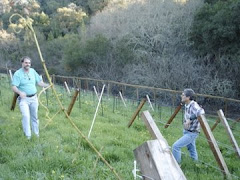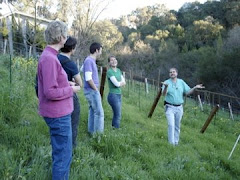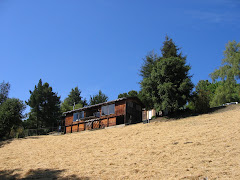For years & years, I have been driving by this little shop on the very edge of Los Altos next to Palo Alto, formerly called "Fermentation Frenzy" (now called MoreBeer!, MoreWine!, MoreCoffee!, More Flavor!, MoreSomething!, take your pick). One year, Kris bought me all the equipment and supplies from there for making beer. And for the last 3 or 4 years I have been popping into the place every once in a while to look at equipment and ponder winemaking. But this year, they know me by my first & last name, and they have also memorized my credit card number!
Well, it really hasn't been hugely expensive, but if I don't need another food-grade 10 gallon plastic fermentation barrel ($21), I need a pound of tartaric acid ($7.95) or just sage advise that I am doing things right ($$ priceless $$)! At any rate, between all the little things one does need for winemaking, these guys have it all, or at the least, they will have it by next Thursday! If you need anything for beer making, winemaking & now coffee roasting, checkout MoreFlavor! Plus they take their time with customers explaining & helping, which can be a double edged sword sometimes. Especially when you forgot to get enough tartaric acid that was suppose to be added before the wine yeast and you are the fifth customer in line!
Well, the crawl space under my house has been converted to a winery for the next few months. [I am actually planning on building (adding on) under our house in the future, so someday I will have a "cellar" or at least a place to store a lot of wine or vinegar.] As I had mentioned in my previous post, I have added the "Meta", and the "Yeast". But I hadn't mentioned that I had to add some tartaric acid to bring the acid level of the "Must" up to 6.5 g/L. And as things go, I hadn't bought enough acid to reach that level, so I had added the Yeast anyway just to get things going. And now I have just added more tartaric acid to bring it up to the desired level. Apparently, the acid protects the wine yeast from harmful bacteria that cannot tolerate that high of acid level.
You know, its just like cooking, you read the recipe for the first time, but you mix up the order or the ingredients or whatever and you try & correct it! And after you have made the dish a dozen times, you can make it by heart, and you might even experiment here & there. Well, I am still at that first stage, reading the recipe for the first time and making little mistakes & corrections. Having said that, wine is also very forgiving, so I still have a fighting chance to make something decent!
And the most wonderful thing is that this whole concoction is starting to smell like wine! Or at least it smells like that strange, wonderful smell I remember from my youth going on tours of wineries up in Napa, through all those caves & cellars, by the huge fermentation barrels on the way to the tasting rooms!
Things are happening very fast & we will be pressing the wine very soon, so we will have another post next weekend to keep updated on pressing matters (a very little joke)! As Nora Jones said in her song, Don't Know Why, "My heart is drenched in wine, ..., but you'll be on my mind, ..., forever."
Intoxicated from under the floor boards of my house,
John






































































































































